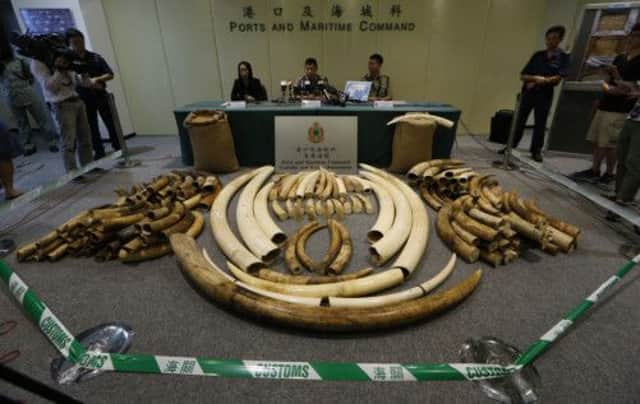Hong Kong urged to destroy confiscated ivory store


The latest shipment, 189 tusks worth $1.5 million (£930,000) hidden in soybean sacks in a shipping container, was one of four major busts this year.
Ivory is known as “white gold” because of the prices it commands on the black market. Hong Kong has put values of between $1,000 and $2,000 a kg on ivory it seized this year. A 2011 report by the International Fund for Animal Welfare said buyers in China were paying up to $2,400 a kg.
Advertisement
Hide AdAdvertisement
Hide AdConservation groups, worried the ivory pile presents a target for theft and fails to send a signal that Hong Kong is serious about cracking down on the trade, are now urging the government to destroy it.
Authorities are resisting, instead preferring to dole out small amounts to schools to raise conservation awareness.
“As long as that ivory is kept anywhere, it will always be a temptation for people to get their hands on it,” said Grace Ge Gabriel, the fund’s regional director.
IFAW and 15 other animal welfare and conservation groups wrote to Hong Kong’s leader and customs commissioner after the October seizure, urging them to follow the example of countries that destroy confiscated ivory.
IFAW estimates 35,000 elephants a year are killed by ivory poachers, risking extinction of the animal in the wild. Demand is fuelled by China’s booming economy, which has created a vast middle class with the ability to buy ivory carvings prized as status symbols.
“The Chinese market remains the paramount destination for illicit ivory,” according to a report this year by the UN, the Convention on International Trade in Endangered Species and wildlife trade monitoring network TRAFFIC. It said China’s involvement has been growing since 1996 despite “increasing levels of law enforcement.”
In their letter, the groups pointed to “high-profile ivory destruction measures” over the years. Kenya held the world’s first large ivory bonfire in 1989, torching 12 tons in an event that drew international attention. Zambia set fire to 9.5 tons in 1992 and Gabon burned nearly five tons in 2012.
In June, the Philippines became the first Asian country to destroy its stocks when it burned and crushed more than five tons of ivory worth confiscated since 2009. The US last week destroyed more than six tons of ivory tusks, carvings and jewellery seized over 25 years and urged other nations to follow suit. Hong Kong’s stockpile is several times bigger and destroying it would be a big task. The government won’t disclose the exact amount, though says the bulk of it is made up of 32.6 tons seized since 2003, with amounts rising sharply in recent years. Some 7.2 tons have been confiscated so far in 2013, double the amount in 2011.
Advertisement
Hide AdAdvertisement
Hide AdOther busts this year include $5.3 million in ivory, rhino horns and leopard skins from Nigeria in August; $2.2 million of ivory from Togo in July; and a $1.4 million shipment from Kenya in January.
“It’s a financial burden on a country to keep such a stockpile,” said IFWA’s Ms Gabriel, adding that ivory has been stolen from stockpiles in other countries.
Government officials say the Hong Kong stockpile is monitored by CCTV and security guards, but won’t reveal its location for security reasons.